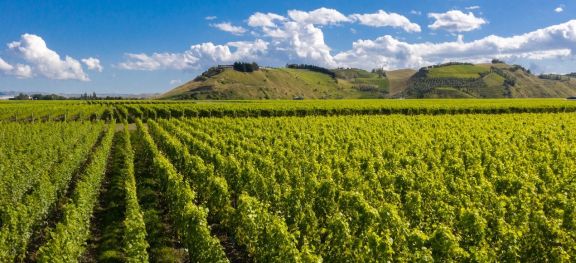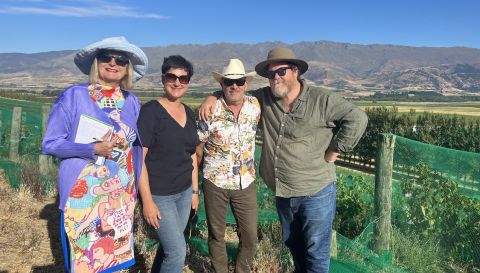NZ 2023 – not to be written-off

A plea from the cyclone-hit east coast of the North Island. Above, the Omahu vineyard in the Gimblett Gravels in January 2023 (photo: Richard Brimer).
Tomorrow we’ll publish the first of many articles about some of New Zealand’s most exciting wines, initially focusing on the country’s quantitatively most important region by far, Marlborough. What gave rise to these articles was my recent 12-day tour of the country organised by a new outfit, New Zealand Fine Wine Producers.
This group has been formed by my fellow Master of Wine Steve Smith, once of Craggy Range and now of Smith & Sheth, in an attempt to open the world’s eyes to the fact that his homeland produces much more than inexpensive, sometimes anodyne, Marlborough Sauvignon Blanc.
With Andrea Pritzker MW, Cameron Douglas MS and, for the second half of the tour, Australian wine writer Nick Ryan, we visited every wine region except for Gisborne, Nelson (I’m still itching to get to Nelson – love Neudorf’s wines) and the relatively new region of Waitaki Valley in North Otago. We were thoughtfully received by a roster of some of the country’s best wine producers, with a well-paced programme of educational tastings and illuminating vineyard visits.
The organisers, who quite coincidentally included David Nash of Atelier Nash, NZ distributors of my glassware, were keenly aware of the carbon emissions tally involved in this ambitious trip and are offsetting 150% of them via investment in a carbon-credit-certified project to build ecosystem health in the Banks Peninsula on the east coast of the South Island. As they point out in the literature about the tour, ‘this project is very close to Akaroa where the French landed in 1838. If not for the sake of three months, the South Island could have been settled by merchants from Bordeaux and Nantes in 1840 instead of the British. What a different wine story that would be!’
I wrote in Dodging Cyclone Gabrielle how our itinerary had to be changed on the hoof as this devastating tropical cyclone approached. Steve Smith lives in Hawke’s Bay, one of the two wine regions, along with Gisborne, worst affected by the cyclone. He has been around long enough to know that vintage reputations throughout a country can be severely damaged by events in just one of its regions and yesterday wrote the following despatch (Aotearoa being the Māori word for Land of the Long White Cloud).
A letter from the vineyards of Aotearoa New Zealand
Steve Smith writes On behalf of all Hawke’s Bay vignerons, thanks to each and every one of you for the heartfelt messages we have had from the wine community all over the world following the cyclone.
I write this letter from my office in Hawke’s Bay on the last day of February 2023. It is raining again. We have had a year’s worth of rain fall on our Heretaunga Plains winegrowing region in just three months – a period when we would normally have had a couple of drought-breaking weather fronts pass through and that’s all. The hills are scarred in places by these rains and remain radiantly green and lush when they would normally be dry and tanned by the summer sun. It has been a summer largely without a summer.
The cyclone was an extreme La Niña weather event in the first instance, part of the normal cycle of the El Niño–Southern Oscillation climate pattern. This is our third year of La Niña, which in itself is highly unusual, and likely the first glimmer of climate-change impacts playing a part. El Niño and benign climate patterns will return and with them great vintages. We will learn and adapt to a different way of dealing with the two or three vintages per decade that are less than ideal and likely to become more dramatic.
In Hawke’s Bay a number of our vineyards and wineries have faced devastating consequences from the cyclone. Our heart goes out to our friends and fellow vignerons. The wine community is rallying behind them as much as possible to help deal with their devastation. Most of the region’s vineyards and wineries are not damaged by silt or flooding, however we are all facing a tough vintage. Many of us have had to deal with less-than-favourable La Niña summers before. There are a few grey beards and strands of luxurious grey hair in Hawke’s Bay now! We will be calling on these experienced heads, great viticulture, and the free-draining soils of the Gimblett Gravels, Bridge Pa, Crownthorpe and Mangatahi districts, alongside small, isolated parcels of sloping, free-draining lands across the region, to get us through.
We need a little love from Ranginui, the sky father – some early autumn sunshine and warmth would not go amiss. Tomorrow is the first day of autumn, the critical period for determining eventual grape and wine quality and the weather forecast is much more promising.
Our desire to produce exceptional wines remains strong. Our will is being challenged. We will do everything we can to prevail. All we ask is that when the Hawke’s Bay wines of 2023 find their way to your glass, you treat each wine on its merits. And further north I’m sure Michael Brajkovich MW at Kumeu River, Duncan McTavish of Man O’War, and Ben Byrne at The Landing will say the same thing.
Finally, the South Island, as is normal under a La Niña weather pattern, basks in the warmth and dryness of a potentially exceptional vintage (I hope I haven’t just jinxed it!). Remember New Zealand is a long skinny wine country stretching over 1,000 miles from top to bottom, with wine regions that are climatically diverse and every year have startling differences in weather patterns. Once again, we ask that you don’t pre-judge the wines from these regions because other parts of the country are having a challenging vintage. Or maybe you judge them now based on the vintage conditions that currently prevail … exceptional!
The writing has finished … the rain has stopped … a couple of days’ drying and time to get picking!
Steve Smith MW
Kaiahuwhenua tō Waina (Vigneron), Aotearoa New Zealand, 28 February 2023
Become a member to view this article and thousands more!
- 15,414 featured articles
- 274,285 wine reviews
- Maps from The World Atlas of Wine, 8th edition (RRP £50)
- The Oxford Companion to Wine, 5th edition (RRP £50)
- Members’ forum
- 15,414 featured articles
- 274,285 wine reviews
- Maps from The World Atlas of Wine, 8th edition (RRP £50)
- The Oxford Companion to Wine, 5th edition (RRP £50)
- Members’ forum
- Commercial use of our Tasting Notes

